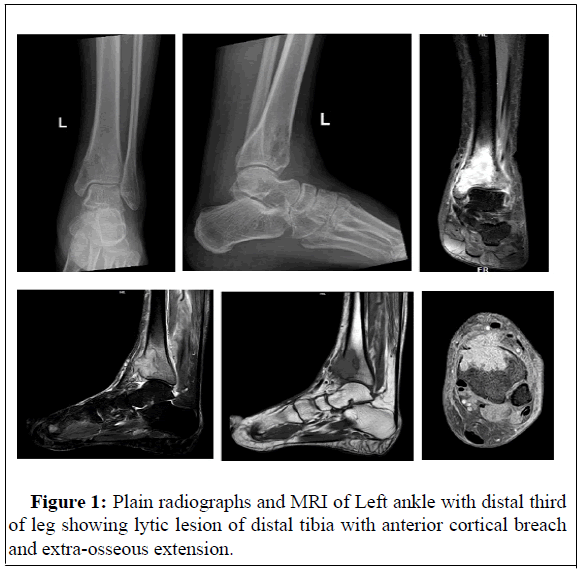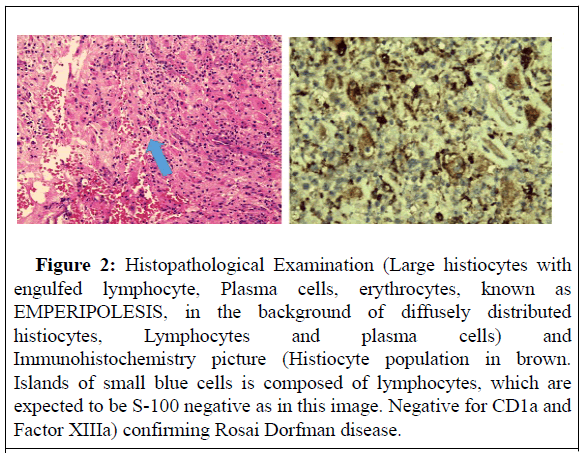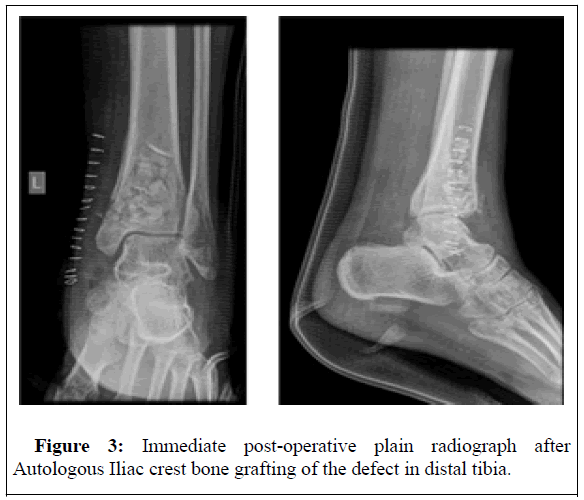Primary Skeletal Rosai Dorfman Disease of Distal Tibia
Received: 28-Jun-2021 / Accepted Date: 12-Jul-2021 / Published Date: 19-Jul-2021 DOI: 10.4172/2472-016X.1000151
Abstract
Rosai Dorfman disease is a non-langerhan cell histiocytosis mainly manifesting as massive painless cervical lymphadenopathy associated with constitutional symptoms in young adults. Isolated skeletal involvement by Rosai Dorfman disease is extremely rare. 48-year-old lady presented with pain and swelling of left ankle of six month’s duration. Radiological investigations revealed lytic lesion of Distal Tibia with cortical breach and extraosseous extension. Histopathological examination of the excised lesion clinched the diagnosis. This presentation of the disease is very uncommon as it primarily involves the osseous tissue without the involvement of lymph nodes, and, considering the age of the patient, middle aged individual. A broader array of differential diagnosis should be kept in the mind of a clinician over and above a neoplastic or infective pathology.
Keywords: Rosai-dorfman disease; Hyperpigmentation; Trauma; Osteomyelitis; Metastases; Biopsy
Introduction
Rosai-Dorfman Disease (RDD) is sinus histiocytosis with massive lymphadenopathy (mainly of the cervical lymph nodes), mainly occurring in adolescents and young adults [1]. In RDD, histiocyte proliferation is presumably reactive and polyclonal, that is nonmalignant [2]. Extra nodal involvement is common and may occur in more than 40% of patients, sometimes without associated lymphadenopathy [3,4]. Bone involvement occurs in less than 10% of cases [3]. Isolated skeletal involvement is very rare, occurring only in 2%-8% of all the patients reported to date [5].
We present a case of isolated skeletal Rosai-Dorfman Disease without lymphadenopathy reported to our hospital. A middle-aged lady presenting to the Orthopedics department with pain and swelling of left ankle of six months duration.
Case Presentation
A 48-year-old lady presented with complaints of pain and swelling of Left ankle associated with difficulty in walking for the past 6 months. There was no history of trauma to the ankle. There was no history of constitutional symptoms such as fever, malaise, significant loss of appetite or weight.
Clinical examination of Left ankle and foot revealed diffuse swelling over the ankle joint, more prominent on the antero-medial aspect. There was slight hyperpigmentation present over the anterior aspect of ankle joint and dorsum of foot. There was no local rise of temperature present over the anterior and medial aspect of the ankle. Anterior joint line tenderness was present over the ankle. Irregularity and thickening over the anteromedial aspect of distal tibia with tenderness was present. Range of movements of ankle was painful. There was no distal neurovascular deficit.
Plain radiographs of the Left ankle revealed an expansile lytic lesion over the antero-medial aspect of distal tibia with cortical break and increased soft tissue shadow anterior to the distal part of tibia and ankle joint. Magnetic Resonance Imaging of the Left ankle with Intravenous contrast showed a well-defined eccentric epi-meta-metadiaphyseal lesion in the sub-articular portion of distal tibia with breech of anterior cortex and extra-osseous component.
Marrow edema was present with overlying smooth enhancing periosteal reaction in distal third of tibia extending for a length of ~6.8 cm from the tibio-talar joint was observed in Figure 1.
Based on the age of the patient, site of the lesion, radiographic findings, the provisional differential diagnoses that were made include-Giant Cell Tumor, Osteomyelitis and Metastases. An open biopsy of the lesion was done. It showed a Friable soft tissue mass breaching the anterior cortex of the medial aspect of distal tibia. Caseous slough like material noted in medullary canal. Thorough curettage of the lesion and saline lavage was given. The specimen was sent for histopathological examination. Due to the suspicion of an infective pathology, bone grafting of the bony cavity was deferred. Histopathological examination of the curetted tissue showed features of Rosai Dorfman disease in Figure 2.
Figure 2: Histopathological Examination (Large histiocytes with engulfed lymphocyte, Plasma cells, erythrocytes, known as EMPERIPOLESIS, in the background of diffusely distributed histiocytes, Lymphocytes and plasma cells) and Immunohistochemistry picture (Histiocyte population in brown. Islands of small blue cells is composed of lymphocytes, which are expected to be S-100 negative as in this image. Negative for CD1a and Factor XIIIa) confirming Rosai Dorfman disease.
After the diagnosis of Rosai Dorfman Disease was confirmed and infective pathology ruled out, patient was taken up for Autologous Iliac Crest Bone grafting of the cavity left in the antero-medial aspect of distal Tibia in Figure 3.
Results and Discussion
Primary skeletal involvement of Rosai Dorfman Disease is very rare, only 2%-8% reported till date [4]. Bone involvement occurs in less than 10% of cases [3]. The classical presentation of Rosai Dorfman Disease is massive painless cervical lymphadenopathy along with constitutional symptoms in a young adult [3,6].
The patient of our study was a middle aged without any lymphadenopathy or constitutional symptoms. This presentation is only rarely reported in the history. The radiological imaging manifestations of RDD in bone are not specific for the diagnosis of this disease. On radiographs, osseous lesions typically have a lytic appearance with ill-defined margins ranging from sclerotic to permeative [7]. The proliferating histiocytes are polyclonal, known as Rosai–Dorfman cells, indicates that these cells are reactive rather than neoplastic [8]. Emperipolesis is the active penetration of one cell by another where the former remains intact [9]. It is non-destructive phagocytosis of inflammatory cells, including lymphocytes, plasma cells, neutrophils, and RBC. Emperipolesis or lymphocytophagocytosisis required for the diagnosis of RDD, the absence of which makes the diagnosis difficult [10]. Immunohistochemistry-CD1a and CK were negative, and CD 68 and S100 were strongly positive confirming the diagnosis as RDD [11,12].
The report of 108 patients having Rosai Dorfman Disease with bony involvement have been made through 88 articles [2]. 59 (55.1%) were female patients and 48 (44.9%) were males. Mean age of patients was 31.1 ± 19.8 years. Age ranged from 3 cases of newborns to a maximum of 79-year-old person. The osseous involvement mainly occurred in cranium, facial bones, and tibia in the decreasing order.
In general, Rosai Dorfman Disease usually requires no treatment and may spontaneously regress in about 80% of the cases [13]. Primary Rosai Dorfman Disease of bone is usually causing no mortality risk and treatment is focused to relieve painful disease or preventing complications such as pathologic fracture. Surgical resection or curettage along with bone grafting are the most described interventions [7].
Conclusion
Primary involvement of skeletal system by Rosai Dorfman disease without lymphadenopathy is very rare. This occurrence is extremely rarely seen in middle aged and elderly individuals. The clinical picture along with the blood investigations and radiological examination may suggest a post-traumatic event, an infective or neoplastic processes. High index of suspicion and prompt referral for a good histopathological examination added upon by immunohistochemistry examination will extract the diagnosis of these type of rare diseases. This will help in managing the condition either non-operatively or by surgical clearance of the lesion with adjunctive therapy, which will provide a good functional outcome for the patient.
Acknowledgement and Disclosure Statement
Our sincere thanks go to the administrative organs of the Kenyatta National Hospital and School of Dental Sciences, University of Nairobi, for the support accorded in the conduct of this work. This study was approved by The Kenyatta National Hospital and The University of Nairobi, Ethics and Research Committee (KNH/UoN-ERC: P70/02/2015).
Funding
No funding sources.
Conflict of Interest
None declared.
Ethical Approval
Not required
References
- Aleksandra Miekus, Joanna Stefanowicz, Grazyna Kobierska-Guilda, Elzbieta Adamkiewicz-Drozynska (2018) Rosai-Dorfman disease as a rare cause of cervical lymphadenopathy-case report and literature review. Cent Eur J Immunol 43: 341-345.
- Birgit A Mosheimer, Bastian Oppl, Shahin Zandieh, Michael Fillitz, Felix Keil (2017) Bone Involvement in Rosai-Dorfman Disease (RDD): A Case Report and Systematic Literature Review. Curr Rheumatol Rep 19: 29.
- Foucar E, RosaiJ, DorfmanR (1990) Sinus histiocytosis with massive lymphadenopathy (Rosai-Dorfman disease): Review of the entity. Semin Diagn Pathol 7:19-73.
- Rodriguez-Galindo C, Helton KJ, Sanchez ND, Rieman M, Jeng M (2004) Extra nodal Rosai-Dorfman disease in children. J Pediatr Hematol Oncol 26:19-24.
- HM Duijsens, FM Vanhoenacker, BP Braakter, PC Hogendoorn, HM Kroon (2014) Primary intraosseous manifestation of Rosai-Dorfman disease: 2 cases and review of literature. J Belg Soc Radiol 97: 84-89.
- WH McAlister, T Herman, LP Dehner (1990) Sinus histiocytosis with massive lymphadenopathy (Rosai-Dorfmandisease), Pediatr Radiol 20: 425-432.
- EG Demicco, AE Rosenberg, J Bjornsson, LD Rybak, KK Unni (2010) Primary rosai-dorfman disease of bone: A clinicopathologic study of 15 cases, Am J Hematol 34: 1324-1333.
- Paulli M, Bergamaschi G, Tonon L, Viglio A, Rosso R (1995) Evidence for a polyclonal nature of the cell infiltrate in sinus histiocytosis with massive lymphadenopathy (Rosai-Dorfman disease). Br J Haematol 91: 415-118.
- Rastogi V, Sharma R, Misra SR, Yadav L, Sharma V (2014) Emperipolesis-A review. J Clin Diagn Res 8: ZM01-ZM02.
- Dalia S, Sagatys E, Sokol L, Kubal T (2014) Rosai-Dorfman disease: Tumour biology, clinical features, pathology, and treatment. Cancer Control 21: 322-372.
- Cangelosi JJ, Prieto VG, Ivan D (2011) Cutaneous Rosai-Dorfman disease with increased number of eosinophils: Coincidence or histologic variant. Arch Pathol Lab Med 135: 1597-1600.
- Efared B, Mazti A, Chaibou B, Atsame-Ebang G, Sidibe IS (2017) Bone pathologic fracture revealing an unusual association: Coexistence of Langerhans cell histiocytosis with Rosai-Dorfman disease. BMC Clin Pathol 17: 5.
- A Pulsoni, G Anghel, P Falcucci (2002) Treatment of sinus histiocytosis with massive lymphadenopathy (rosai-dorfman disease): report of a case and literature review, Am J Hematol 69: 67-71.
Citation: Arun VP (2021) Primary Skeletal Rosai Dorfman Disease of Distal Tibia. J Orthop Oncol 7: 151. DOI: 10.4172/2472-016X.1000151
Copyright: © 2021 Arun VP. This is an open-access article distributed under the terms of the Creative Commons Attribution License, which permits unrestricted use, distribution, and reproduction in any medium, provided the original author and source are credited.
Share This Article
Recommended Journals
Open Access Journals
Article Tools
Article Usage
- Total views: 1692
- [From(publication date): 0-2021 - Dec 22, 2024]
- Breakdown by view type
- HTML page views: 1150
- PDF downloads: 542



